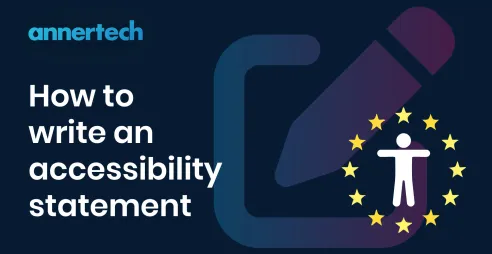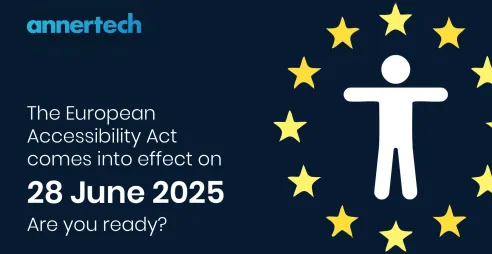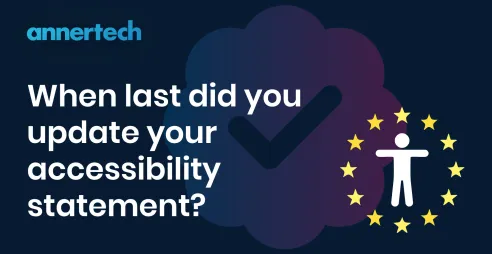Celebrating Global Accessibility Awareness Day today

Today is the 12th Global Accessibility Awareness Day! But what does it mean, and why are we highlighting it?
More than 1 billion people have some sort of disability. The internet is the one place where it should technically be easy to level the playing field on inclusivity, yet the latest report on the accessibility of the internet is rather depressing.
The WebAIM Million 2023 report, which analyses the accessibility of the world's top 1,000,000 home pages, shows a very slight improvement on the 2022 report. But the reality is that 96.3% of these home pages had Web Content Accessibility Guidelines conformance failures.
Although this has improved very slightly – from 96.8% in 2022 - it’s worth bearing in mind that these are automatically detected errors, so the actual WCAG 2 A/AA conformance level is certainly lower.
96.1% of all errors detected fall into just six categories. These most common errors have been almost the same for the last five years. Addressing just these few types of issues would significantly improve accessibility across the web.
Most common accessibility failures (% of home pages)
- 84% - Low Contrast Text
- 58% - Missing alternative text for images
- 50% - Empty Links
- 46% - Missing Form Input Labels
- 19% - Missing Document Language
- 28% - Empty Buttons
– Source: The WebAIM Million 2023 report
“From the latest WebAIM report we see that some sectors, such as government and education, fared better than others. This is encouraging, because many of these are public sector websites and offer essential services to users,” commented Tom Bamford, an accessibility specialist with Annertech.
Tom is passionate about making the internet as inclusive and user friendly as possible and advises clients on how to improve their accessibility rating.
“Tim Berners-Lee, inventor of the World Wide Web, is widely quoted as saying that ‘the power of the web lies in its universality. Access for everyone, regardless of disability, is an essential aspect.’ Although the report shows that there has been slight progress over the years, considerable work still needs to be done to make the web accessible to everyone,” said Tom.
A significant part of this work is awareness, and this is where Global Accessibility Awareness Day comes in. It happens every year on the third Thursday in May, and is run by the GAAD Foundation, whose mission is to “disrupt the culture of technology and digital product development to include accessibility as a core requirement”.
The purpose of this day is awareness – to get everyone talking, thinking and learning about digital access and inclusion, and the many people with disabilities or impairments.
Common disabilities/impairments
- Visual – People who are blind need alternative text descriptions for meaningful images and will use the keyboard and not a mouse to interact with interactive elements.
- Hearing – People who are deaf or hard of hearing need captioning for video presentations as well as visual indicators in place of audio cues.
- Motor – People with motor impairments may need alternative keyboards, eye control or some other adaptive hardware to help them type and navigate on their devices.
- Cognitive – An uncluttered screen, consistent navigation and the use of plain language is useful for people with different learning disabilities/impairments.
Why are inclusivity and accessibility so important?
Besides the fact that accessing important information and services is a civil right, from a business perspective, people with disabilities are under-served by today’s digital products.
This is a large chunk of a potential customer base that an inaccessible website may have wiped out.
In a Nucleus Research study titled “The Internet is Unavailable”, researchers Rebecca Wettemann and Trevor White found that companies with inaccessible sites are losing $6.9 billion a year to competitors whose sites are accessible.
“If you have problems with accessibility in your digital channel, you are pushing more calls, more traffic, and more work to your call centre even if consumers abandon the transaction,” Wettemann and White wrote.
Making your website accessible, in particular retrospectively, will require some investment. There are other reasons why organisations should prioritise accessibility besides saving money in the long run and accessing a larger market.
These include:
- Positive brand association
- Ease of use
- Improved SEO
- Reduction of potential legal risks
What can you do?
The first step to having an accessible website is to figure out where you are at the moment.
1. If you don’t have a website
If you are in the process of setting up a new website this is where accessibility starts: right at the beginning of the process. Any digital agency worth its salt will have accessibility built into the design of the website. In fact, digital agencies around the world are playing a major part in making the internet more accessible.
Any public sector website should be at least WCAG 2.1 AA compliant, and it’s a good standard for all websites to emulate.
The National Disability Authority also has some excellent guidelines to ensure compatibility with the EU’s directive on accessibility.
2. If you have a website
Type your home page address into wave.webaim.org and have a look at the results. They will give you a good idea of the issues that need to be fixed.
These might be quite quick and easy to solve, but if they start to seem complex or overwhelming it might be worth getting an agency to have a look.
If you’re feeling confident about maintaining accessible digital platforms in-house, this step-by-step guide will help you ensure that high standards of accessibility are attained.
Conclusion
No matter where you are in the process, the most important thing is to get started. Even small tweaks can go a long way to breaking down the barriers that users face in a digital world.
Let’s do our bit on Global Accessibility Awareness Day to see if we can bring down the numbers of accessibility errors, so next year’s report reflects positive strides towards an inclusive internet.

Are you tackling accessibility head-on?
Whether you decide to fix your website retrospectively or start from scratch, Annertech is here to advise you every step of the way.
Get in touch


